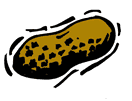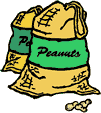
Grades K-2, 3-5

Don't have an account yet? Sign up for free
Don't have an account yet? Sign up for free

 Do you know what peanuts, pecans, and peas all have in common? They are all plants that end up feeding the soil in which they have been planted. That was new news back at the turn of the century! In this lesson you will learn how an African American scientist named George Washington Carver took that knowledge and changed the way farmers farmed.
Do you know what peanuts, pecans, and peas all have in common? They are all plants that end up feeding the soil in which they have been planted. That was new news back at the turn of the century! In this lesson you will learn how an African American scientist named George Washington Carver took that knowledge and changed the way farmers farmed.
At the end of this lesson you will answer a list of questions showing the difference the peanut made to the farmers in the south. You will identify ways in which Carver was an inventor and an innovator by listing an invention and an innovation that Carver made.
In thinking about the economy of any country, there are three basic economic questions that need to be asked. What goods and services does the country need? How will those goods and services get produced? For whom will the goods and services be produced? Countries make these decisions in different ways. In the United States these questions get answered by consumers and producers.
 Back in the early 1900’s, farmers in the South grew mostly cotton and tobacco. Those crops were grown on individual farms by sharecroppers and farmers. Cotton and tobacco was grown for the entire United States and it was also sold to other countries.
Back in the early 1900’s, farmers in the South grew mostly cotton and tobacco. Those crops were grown on individual farms by sharecroppers and farmers. Cotton and tobacco was grown for the entire United States and it was also sold to other countries.
 Along came a great scientist out of Tuskege Institute and he knew how terrible things were going to happen to the South and that it was going to change the economics of the entire area! He knew that there was a small bug called the boll weevil and it had started eating and ruining the cotton crops. He also knew that cotton and tobacco plants were depleting the soil of its nutrients and that very soon the land was going to produce less and less.
Along came a great scientist out of Tuskege Institute and he knew how terrible things were going to happen to the South and that it was going to change the economics of the entire area! He knew that there was a small bug called the boll weevil and it had started eating and ruining the cotton crops. He also knew that cotton and tobacco plants were depleting the soil of its nutrients and that very soon the land was going to produce less and less.
 Something needed to be done! George Washington Carver knew that the farmers in the South had to grow something else or the farmers were going to lose everything. He discovered that if they grew peanuts, peas, pecans, or sweet potatoes then the soil would get better. Cotton and tobacco zapped the nutrients OUT of the soil, but peanuts, peas, pecans, and sweet potatoes put nutrients back INTO the soil.
Something needed to be done! George Washington Carver knew that the farmers in the South had to grow something else or the farmers were going to lose everything. He discovered that if they grew peanuts, peas, pecans, or sweet potatoes then the soil would get better. Cotton and tobacco zapped the nutrients OUT of the soil, but peanuts, peas, pecans, and sweet potatoes put nutrients back INTO the soil.
But there was an even bigger problem. The country did not want peanuts! How do you think that would change your response the the first question you answered (if it would change it at all)?
George Washington Carver knew what he had to do. He had to talk the entire country into wanting peanuts! He took peanuts and INVENTED new products made with peanuts. Go to the Carver Peanut Products page to find a list of those products. After George Washington Carver invented new uses for the peanut, what are the answers to the three basic economic questions of the South?
George Washington Carver was an INNOVATOR as well. An INNOVATION is when a person figures out a new way to do something better with an item that has already been invented. Carver’s INNOVATION was to find out that if a farmer rotated his crops (tobacco one year, peanuts the next) then more tobacco was produced because the soil was enriched by the peanuts.
Read more about George Washington Carver at:
See how you do answering the questions on this Interactive Activity.
Countries face choices and makes decisions about three basic economic questions: What goods and services will be produced? How will the goods and services be produced? For whom will the goods and services be produced? The economy of a whole area can be affected if the producers make a wrong decision!
“Standard of living” refers to how people are doing as far as money is concerned. Look over the questionnaires that you filled out. Write a paragraph about what you think happened to the farmer’s standard of living when they started rotating their crops. Why do you think that is what happened?

Grades K-2, 3-5

Grades 3-5, 6-8

Grades 6-8

Grades 6-8, 9-12
